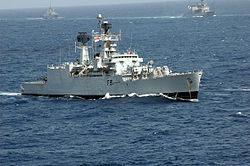| Indian Navy | |
|---|---|
| Bharatiya Nausena | |
 Ensign of the Indian Navy | |
| Country | India |
| Role | Naval warfare |
The Indian Navy, which is the naval warfare branch of the Indian Armed Forces, has approximately around 145 surface combatants and submarines on active commission. [1]
Contents
- Historical fleet
- Submarine fleet
- Surface fleet
- Aircraft carriers
- Amphibious warfare ships
- Destroyers
- Frigates
- Corvettes
- Patrol vessels
- Auxiliary fleet
- Replenishment ships
- Instrumentation ships
- Research and survey vessels
- Diving support vessels
- Training ships
- Tugboats
- Miscellaneous vessels
- See also
- References
By forethought, the IN's Maritime Capability Perspective Plan (MCPP) for the period 2012–2027 had set the objective of the service becoming a 250-ship fleet by 2035. [2] However, as of November 2025, the service expects to achieve a fleet size of over 200 ships and submarines by the time and the numbers could reach only 230 in 2037. [1] [3]
By inventory, the IN's principal assets include its aircraft carrier component – the service has operated a total of four aircraft carriers since 1961; its submarine component – which presently includes a strategic submarine force; and its amphibious component – which principally oversees humanitarian operations. [4] Nevertheless, the IN still lacks certain capability-specific assets – such as mine countermeasures vessels, or are quantitatively inadequate – such as attack submarines. [5]
The IN's fleet inventory is divided amongst its three regional formations:
- Western Naval Command: Headquartered in Mumbai, it consists of the Western Fleet – responsible for naval operations in the Arabian Sea, which flanks India's western coastline. [6] Given its geographical location, it is central to any conflict involving Pakistan. [7]
- Eastern Naval Command: Headquartered in Visakhapatnam, it consists of the Eastern Fleet – responsible for naval operations in the Bay of Bengal, which flanks India's eastern coastline. [6] In addition, it serves as the home command of India strategic submarine fleet – which oversees the country's nuclear second-strike deterrence. [8]
- Southern Naval Command: Headquartered in Kochi, it is the IN's largest command – responsible for service's training requirements. [6]





















































